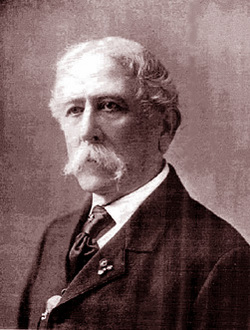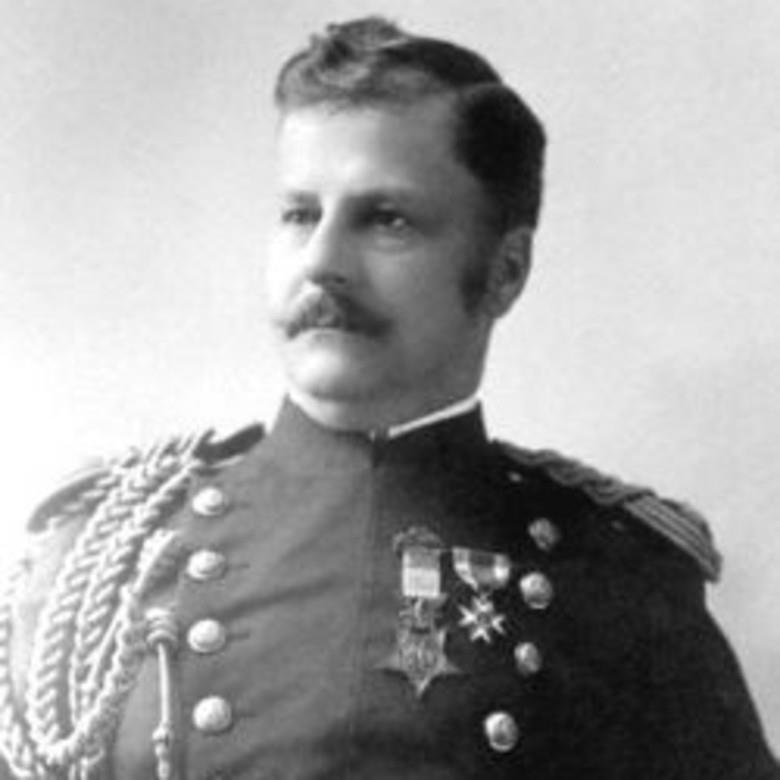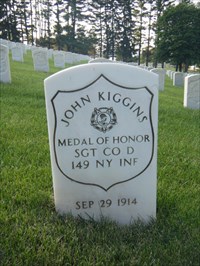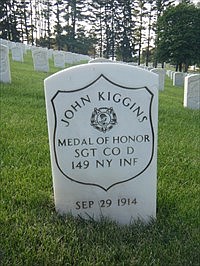While Andrews' Raiders were the first recipients of the Medal of Honor, they were not the only individuals recognized "for particular deeds of most distinguished gallantry in action" while engaged in combat in the Chattanooga region.
As the regulations relative to the earliest Medals of Honor noted "In order that the ... Medal of Honor may be deserved, service must have been performed in action of such a conspicuous character as to clearly distinguish the man for gallantry and intrepidity above his comrades - service that involved extreme jeopardy of life or the performance of extraordinary hazardous duty." That one can stand near the Tennessee River and glance toward Chattanooga, Chickamauga, Missionary Ridge, Lookout Mountain and Wauhatchie and be reminded of Medal of Honor recipients denotes the intensity of the fighting and the valorous actions of numerous soldiers. These stories of individual displays of commitment, sacrifice, courage and integrity still inspire.
 Capt. Moses Veale / Contributed photo
Capt. Moses Veale / Contributed photo
Consider Capt. Moses Veale of Company F, 109th Pennsylvania Infantry. The Battle of Wauhatchie, fought on Oct. 18, 1863, pitted Gen. J. W. Geary, Second Division of the Twelfth Army Corps, against Gen. James Longstreet's Division of Gen. Lee's Army Corps. Gen. Geary, with less than 1,500 men, was very well aware that Confederate troops were billeted in the area after a local woman sent word to Geary that the Rebs were gathering beneath Lookout Mountain. Shortly after midnight, the Union forces fell under attack, with little protection other than a rail fence reconstructed to serve as a breastwork. In more than three hours of intense fighting, men and horses fell so rapidly that only two guns in the artillery could be used. Yet, the Union forces refused to yield to the superior numbers.
Among the courageous troops was Veale, in the thickest area of the fight, who displayed, according to Gen. Geary's report to Washington, the "coolness, zeal, judgment and courage." Capt. Veale was struck four times by enemy bullets, his horse was shot from beneath him and yet he refused to give up or abandon his post, remaining at the head of his company, directing his men's fire. Geary penned that "the enemy realized their numerical strength was nothing against such bravery and valor."
 1st Lt. Arthur MacArthur Jr. / Contributed photo
1st Lt. Arthur MacArthur Jr. / Contributed photo
While most would recognize the name of Gen. Douglas MacArthur, MOH, and many would recognize a photograph of the general and his famous pipe, few know the story of his father, 1st Lt. Arthur MacArthur Jr., 24th Wisconsin Volunteer Infantry, U.S. Army, who was awarded the Medal of Honor for action on Missionary Ridge. On Nov. 25, 1863, MacArthur was one of more than 50,000 Union soldiers who stormed Confederate defenses along the ridge. When the soldier responsible for carrying their unit's flag was mortally wounded, MacArthur grabbed the flag, shouted "On Wisconsin!" and ran full speed toward the Confederate lines. He was shot twice before planting the flag in the middle of the Southerners' fortifications. Inspired by his courage, more than 15,000 Union troops followed and by sunset, the Confederates retreated toward Georgia, leaving the Union in control of the "Gateway to the Deep South." It is alleged that Gen. U.S. Grant declared that "a nail had been driven into the coffin of the Confederacy." Interestingly, MacArthur was only 18.
And, then there is the story of Sgt. John Kiggins, Company D, 149th New York Volunteers, and the Battle for Lookout Mountain. Kiggins was awarded the Medal of Honor for risking his life to save his comrades, who were receiving "friendly fire" from their own batteries. Capt. George K. Collins, wrote about the Nov. 24, 1863, incident, noting that "Sergeant Kiggins, color-bearer for the regiment, advanced ... , got up on a stump and waved his flag to attract the attention of the artillerymen, averting a serious disaster. ... He drew the enemy fire upon himself and nine bullet holes in his clothing, besides one through his cap ... attest to the accuracy of the fire."
 This is the gravesite of Sgt. John Kiggins, who was awarded the Medal of Honor for risking his life to save the lives of his comrades at the Battle for Lookout Mountain. / Contributed photo
This is the gravesite of Sgt. John Kiggins, who was awarded the Medal of Honor for risking his life to save the lives of his comrades at the Battle for Lookout Mountain. / Contributed photo
Each of these three recipients reminds us that strength of character is paramount in the fight against evil and, equally important, that ordinary individuals are capable of extraordinary feats of valor. The examples provided by these men translate into lessons capable of inspiring a new generation, ultimately changing lives and changing communities.
Linda Moss Mines is the Chattanooga and Hamilton County historian, vice president of education for the Coolidge National Medal of Honor Heritage Center and regent of the Chief John Ross Chapter, NSDAR.
Read more Chattanooga History Columns
- Gaston: Paul John Kruesi was Edison's right-hand man
- Robbins: The old Richardson's house and the Civil War
- Gaston: James Williams was a man of the world
- Raney: Mason Evans, the 'Wild Man of the Chilhowee'
- Gaston: The legacy of Adolph Ochs endures
- Martin: Ed Johnson said, 'I have a changed heart,' the day before his lynching in Chattanooga on 1906
- Thomas: The inventiveness of Judge Michael M. Allison
- Moore: Chattanooga's first Chinese community
- Summers, Robbins: Chattanooga's Tuskegee Airman - Joseph C. White
- McCallie: The Civil Rights Act of 1964 says so!
- Gaston: John McCline's Civil War - from slave to D.C. parade
- Raney: Exploring Chattanooga businesses in the Green Book
- Elliott: Remembering the Freedmen's Bureau in Chattanooga
- Gaston: Nancy Ward was a beloved, respected Tennessean
- Martin: Prohibition - the noble experiment
- Elliott: 'A shameful, disgraceful deed': The destruction of the Sewanee cornerstone
- Gaston: Robert Cravens was ironmaster, Chattanooga area's first commuter
- Robbins: Dr. T.H. McCallie's Christmas 1863
- Robbins: Journalist writes of a trip to Missionary Ridge in 1896
- Summers, Robbins: Mine 21 disaster - gone but not forgotten
- Elliott: Collegedale incorporates to avoid Sunday 'blue laws'
- Gaston: 'Marse Henry' Watterson's journalism fame began in Chattanooga
- Robbins: Orchard Knob battle recalled in 1895
- Elliott: Chattanoogans joined in an 'orgy of joy and gladness' on Armistice Day, 1918
- Thomas: Noted service, speakers are marks of Rotary Club of Chattanooga since 1914
- Summers and Robbins: Remembering noted Tennessee author North Callahan
- Raney: 'I auto cry, I auto laugh, I auto sign my autograph'
- Gaston: Sequoyah's alphabet enriched Cherokees
- Robbins: A look at Sam Divine's life during the Civil War
- Robbins: Memories of a Confederate nurse
- Robbins: More notes from Bradford Torrey's 1895 visit to Chickamauga Battlefield
- Robbins: Journalist in 1895 details visit to Chickamauga Battlefield
- Elliott: Telephone exchange firebombing was distraction for grocery store robbery
- Gaston: Worcester brought Christ's message to Cherokee at Brainerd Mission
- Robbins: 1896 travel diary: 'A Week on Walden's Ridge'
- Gaston: Elizabeth Strayhorn, WAC Commandant at Fort Oglethorpe
- Robbins: The history of the Friends of Moccasin Bend National Park
- Moore: Do you own a Sears Roebuck home?
- Summers and Robbins: Camp Nathan Bedford Forrest in World War II
- Gaston: Hiram Sanborn Chamberlain remembered
- Elliott: Daisy the center of tile, ceramic manufacturing in Hamilton County
- Gaston: FDR inaugurates the Chickamauga Dam
- Summers, Robbins: Interned WWII Germans had it easy at Camp Crossville
- Elliott: A war correspondent on Lookout Mountain
- Gaston: Chickamaugas finally bury hatchet in Tennessee Valley
- Gaston: Chickamaugas in Chattanooga
- Robbins: The history of the Riverbend festival
- Raney: Sadie Watson, the first woman elected in Hamilton County government
- Moore: Remembering Chattanooga's Hawkinsville community
- Elliott: Welsh coal miners transformed Soddy after the Civil War
- Gaston: Chattanooga's best-kept secret
- Elliott: Cabell Breckinridge loses his horse
- Raney: Martin Fleming is the people's judge
- Gaston: The amazing career of Francis Lynde
- Martin: Hamilton County's Name Sake: Alexander Hamilton
- Summers, Robbins: The crosses at Sewanee
- Bledsoe: The fiery truce at Kennesaw Mountain
- Moore: Talented architect's life cut short by tragedy
- Rydell: Chattanooga's place in soccer history
- Robbins: Tennessee Coal, member of the First Dow Jones Industrial Average
- Raney: In the barber chair
- Lanier: Becoming the Boyce Station Neighborhood Association
- McCallie: John P. Franklin: Living history among us
- Barr: Chattanooga's first railroad: The Underground Railroad
- Summers, Robbins: Charles Bartlett was a Pulitzer Prize winner, Kennedy confidant
- Rainey: 'We have seen it'
- Elliott: Feinting and fighting at Running Water Creek and Johnson's Crook
- Gaston: The Spring Frog Cabin at Audubon Acres
- Raney: Wauhatchie Pike was moonshine motorway
- Robbins: Oakmont was home of venerable Williams clan
- Summers and Robbins: Rebirth of the Mountain Goat Line
- Elliott: Bad investments led to Soddy Bank failure in 1930
- Summers and Robbins: Pearl Harbor attack left football behind
- Gaston: Jolly’s Island namesake had long ties with Sam Houston
- Return Jonathan Meigs, Indian Agent
- Moore: Did you know about St. Elmo's other two cemeteries?
- Summers: Orme - Marion County's almost lost community
- Davis: Spooky revival at Sharp Mountain in 1873
- Robbins: The story of Longholm
- Raney: Women labored to help the U.S. win World War I
- Even in the city, the 'wheel' changed everything
- Murray: Confederate dilemma after Chickamauga
- J.B. Collins — Newsman extraordinaire
- Robbins: The Story of the Lyndhurst Mansion
- Chattanooga artist and wife lost on the Lusitania
- Chattanooga History Column: Battelle, Alabama and the Battelle Institute
- John Ross, a founder of Chattanooga
- Hamilton County casualties in World War I
- Chattanooga Power Couple
- 'Somewhere in France'
- The Ray Moss family
- Battery B from Chattanooga
- Ulysses S. Grant, Clark B. Lagow, and the Chattanooga Bender
- Songbirds Museum Timeline
- Hamilton County World War 1 roster
- The Soddy Girl and the Memphis Belle
- Blues icon Bessie Smith was the Empress of Soul
- Women's Army Corps at Chickamauga
- Emma Bell Miles' life at the top of the 'W'
- The Tivoli Wurlitzer is one of Chattanooga's priceless assets
- Chattanooga in struggle for freedom during Civil War
- October 1918, Chattanooga paralyzed by Spanish flu epidemic
- Eli Lilly and the Ditch of Death
- One hundred years ago, Chattanooga goes to war
- The legacy of Anna Safley Houston
- Harriet Whiteside was ahead of her time
- Southern Adventist University
- Chattanooga native's writings aided Civil Rights movement
- Zion College, Chattanooga's only African American College
- The North Shore's hidden past
- Mayme Martin -- Businesswoman and community leader
- Thomas Sim's epic struggle for freedom
- Top of Cameron Hill was price of rerouting interstate
- Cameron Hill has rich history
- Temperance movement included Harriman university
- The sweetest music this side of Heaven
- Conquistadors at Chattanooga
- Chattanooga and the 'General'
- Chattanooga's first Thanksgiving, 1863
- Chattanooga's greatest flood caught city unaware
- Opening the Cracker Line
- European trip in 1900 enlightens Sophia Scholze Long
- Sophia Scholze Long spoke out when others were silent
- Little South Pittsburg and its big silent movie stars
- Lot attendant recalls hottest job in Chattanooga
- Chattanooga's Forest Hills is final resting place for known, unknown
- Burritt College -- Pioneer of the Cumberlands
- Chattanooga's nicknames trace city's evolution
- The 25th annual meeting of the Tennessee Press Association
- Clemons Brothers Furniture Store
- The Short Life of the USS Chattanooga
- Ellen Jarnagin McCallie lived a truly remarkable life
- Dr. Jonathan Bachman was a revered city father
- Second guessing the Confederate failure on Missionary Ridge
- Nancy Kefauver, ambassador for the arts
- William Gibbs McAdoo kept his Southern roots
- Chattanooga's Secretary of the Treasury
- Howard Baker remembered as a statesman/photographer who snapped history
- Tivoli's last picture show
- The history of one of Chattanooga's oldest businesses
- Chattanooga's roller derby skaters
- Myths of Coca-Cola in Chattanooga
- Chattanooga's neighborhood grocery stores
- The tale of the Scottsboro Boys
- The people's history of Chattanooga
- Howard School is Chattanooga's reminder of Reconstruction
- Elevator operator, painter, mystery man: meet Rice Carothers
- Raulston Schoolfield made enemies amid his rise to power
- Website lets users peer into Chattanooga's past
- The flood of 1917
- Chattanooga's 'wickedest woman' buried at Forest Hills
- History of Cummings Highway



